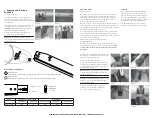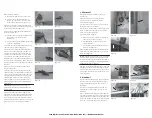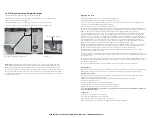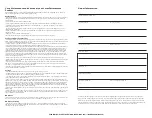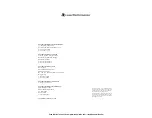
14. Fitting the Stratos Engine Bracket
• Position the fi rst bolthole as shown in the above diagram.
• Bolt bracket to transom using only the fi rst single bolt hole. (Use a 6 mm drill bit)
• Align top of bracket horizontally to boat.
• Drill through ply bracket to position the other 5 holes. (Use a 6 mm drill bit)
• Ensure all boltholes are watertight by using silicone sealant during fi tting.
(position of fi rst bolt hole) fi gure 63
complete fi tted position
fi gure 64
Righting the Boat
1.
Ensure all members of the crew are accounted for and safe.
2.
If the gennaker is deployed, drop the sail back in to the sock.
3.
Release the main/jib sheets and vang from respective cleats and ensure the sheets are fully extended
to avoid the boat sailing immediately after righting.
4.
If the boat inverts, fi rst recover the boat on to its side.
5.
In adverse conditions and with more than two crew, it is recommended that the largest crew member
swim to the bow and hold the bow during righting and until all other crew members have reboarded after
righting. (Th
is ensures the boat swings into the safe head in to wind position upon righting).
6.
It is recommended to use the “scoop” recovery system for crewmembers not involved in the righting
procedure. When the boat is on its side, the crew members to be scooped should move to the inner lower
side of the boat as close to the center of the boat as possible. As the boat is righted, these crew members
will be “scooped” onboard the boat and will then be ready to help others reboard. “Scooping” should only
be attempted with practice and should only be commenced after the boat is stabilized on its side by a
crewmember who is securely located on the centerboard and holding the capsize righting line under the
gunwale. Th
is is to prevent the boat from inverting and potentially trapping the crew.
7.
Righting is eff ected by a crewmember standing on the centerboard moving out towards the end of the
board whilst leaning out holding on to the righting line. Th
e boat will recover to the upright position
quickly. It should normally only require one average size person to right the centerboard.
8.
Immediately after righting the tiller should be pushed fully towards the mainsail to stop the boat
sailing until all crew have reboarded.
9.
Reboarding can be undertaken over the windward side of the boat using the righting line as a step or
over the transom. A grab rail is positioned on the inner face of the sub deck to assist with pulling yourself
back in to the boat.
10.
If the person in charge of the boat or the crew are inexperienced in capsizing and righting procedures
it is advised to practice drills under skilled supervision and in any event, close to assistance prior to the
drill being used in earnest.
11.
All crewmembers should wear an approved buoyancy aid at all times while on the water.
Saftey Afl oat
Th
is instruction manual is not a guide to sailing your craft and it should not be considered suitable for the
task of learning to sail a boat. Please read the manual before rigging and sailing your Stratos Keel.
Before You Go Sailing:
1.
Ensure you are wearing suitable clothing and safety equipment for the conditions and time of year.
2.
Always wear a buoyancy aid or life jacket
3.
Make sure a third party knows where you are sailing and how many of you are sailing.
4.
Check the weather forecast.
5.
Check the time of high and low tides if applicable.
6.
Seek advise on local conditions if you are sailing in a new area.
7.
Always check the condition of your craft before setting off .
8. Contact with overhead electrical wires could be fatal, exercise extreme caution when raising the
mast, launching & sailing.
On the Water
1.
Conform to the sailing rules of the road.
2.
Look out for changing weather conditions.
3.
Never sail beyond your ability or that of your crew.
4.
Understand and pratice competent sailing skills and righting techniques.
Warning:
Keeping your LaserPerformance product on a mooring. It is well publicized that
glass reinforced plastic (GRP) boat hulls are susceptible to osmosis and wicking, if stored
on a mooring for prolonged periods without a protective barrier in addition to the gel coat.
Similar conditions can be created when a hull is placed in a transport cover when it is wet and
the cover is not removed at the end of the journey. Th
is is a particular risk in hot and humid
conditions. If you plan to moor your boat on a mooring for more than 2 weeks, we recommend
an osmosis barrier coat.
Fogh Marine | 416 251-0384 | www.foghmarine.com | info@foghmarine.com



